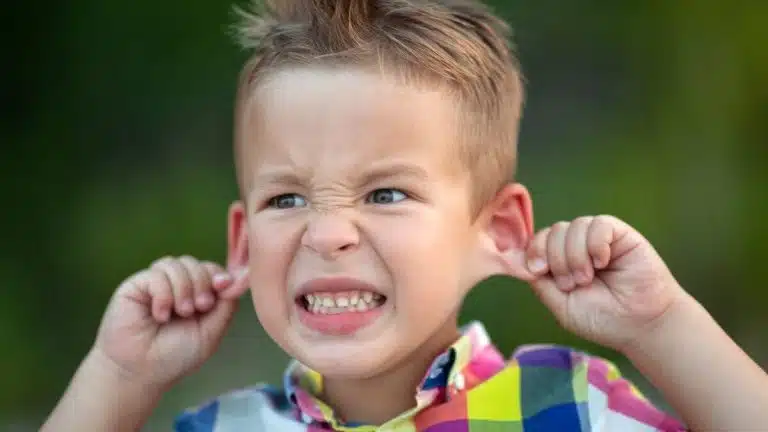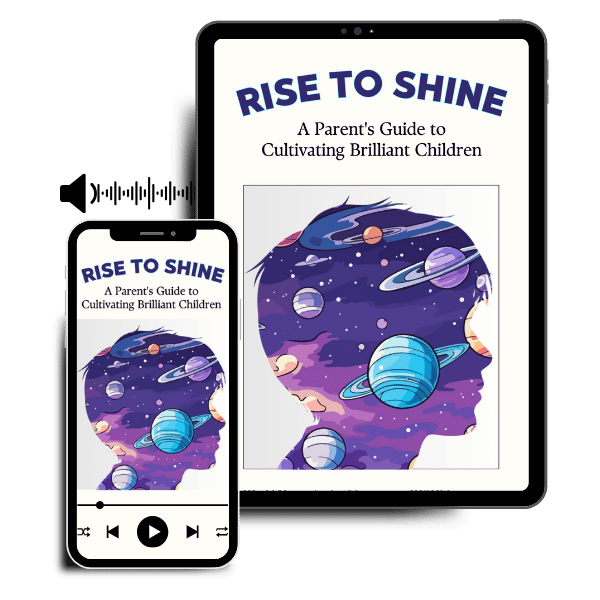Types of Language in Early Childhood: Parent’s Communication Guide


Embarking on the early childhood language development journey is exciting and crucial for building a strong communication foundation with your little one. From the first coos and babbles to forming words and sentences, every step is a milestone towards understanding the world around them and expressing their unique personality. This helpful, research-based article explores the various stages and types of language in early childhood development and the meaning behind different behaviors. It provides insightful tips on how you can support your child’s linguistic growth.
Whether it’s the verbal excitement of naming objects or the non-verbal gestures that convey their emotions, each mode of communication holds significance.
Discover how imaginative play fuels linguistic growth and how understanding and addressing behavioral communication can pave the way for verbal expression. This guide also offers a nurturing roadmap towards transitioning from behavioral to verbal communication, ensuring your toddler feels understood, valued, and supported every step of the way.
The journey from coos and babbles to forming words resembles a delicate dance. Each step forward is a leap into the world of expression, where every sound uttered is a note in their unfolding melody of communication. Here’s a glimpse into this enchanting journey:
The experience of verbal communication is nothing short of magic. With each new day, the repertoire of words expands, paving the way for endless conversations.
Simple words like “mama,” “dada,” and “no” are monumental, each a stepping stone towards a vast linguistic landscape.
As toddlers merge words, sentences bloom. “Want cookie” may seem simple, yet it’s a profound leap in linguistic prowess.
| Developmental Milestone | Achieved |
|---|---|
| Responds when called from another room | YES / NO |
| Hears TV or radio at same level as others | YES / NO |
| Answers basic "Who?" "What?" "Where?" "Why?" questions | YES / NO |
| Discusses activities at daycare, preschool, or friends' homes | YES / NO |
| Forms sentences with four or more words | YES / NO |
| Speaks easily without repeating syllables or words | YES / NO |
Discover our related article: Language Skills for 3-Year-Olds: Speech Milestones & Checklists.
| Developmental Milestone | Achieved |
|---|---|
| Attends to a short story, answers simple questions about it | YES / NO |
| Understands most conversations at home and in school | YES / NO |
| Constructs detailed sentences | YES / NO |
| Narrates on-topic stories | YES / NO |
| Communicates easily with peers and adults | YES / NO |
| Pronounces most sounds correctly except few | YES / NO |
| Engages with rhyming words | YES / NO |
| Identifies some letters and numbers | YES / NO |
| Utilizes adult grammar | YES / NO |
Beyond words, myriad expressions and gestures enrich the tapestry of early communication.
A smile, a frown, the twinkle in their eyes; each narrates a tale of emotions and desires.
Gestures are like whispers in a bustling world, subtle yet laden with meaning. A point, a wave, a clasp of hands speaks volumes, enhancing the dialogue between heartbeats.
The path of early language is a whimsical journey filled with moments of awe, joy, and boundless love. As we venture deeper into the heart of toddler communication, every gesture, every word uttered, and every emotion expressed becomes a cherished verse in the beautiful narrative of growing up.
Through understanding and nurturing, we get to be the privileged companions in this wondrous expedition, discovering the eloquence of love and life through the tender lens of early childhood language.
In the heart of a child, imagination blossoms freely. It’s here that symbolic language takes root. This type of language lets toddlers use words or actions to represent their thoughts and real-world concepts. For example, a simple cardboard box transforms into a rocket, ready to soar into space.
Pretend play is a playground for language development.
When a child assumes the role of a doctor, a teacher, or a chef, they step into a world brimming with new words and ways to communicate.
Playful scenarios nurture their vocabulary, sentence construction, and conversation skills.
Toddlers often exhibit behaviors to communicate their needs, feelings, or even discomfort. It’s like cracking a code where actions replace words.
A hit followed by laughter might be a playful attempt for attention. However, it’s a cue to teach gentler ways of interaction.
When a toddler tugs at your clothes, they might seek attention, signaling their need for comfort or help.
This could be an exploration of cause and effect or a way to express frustration. It’s an opportunity to introduce words like “upset” or “help.”
A universal sign of wanting or needing something. It’s a prelude to using words to express desires.
Tantrums often signal frustration, while crying indicates distress or need. Both behaviors are opportunities to help toddlers find words for their emotions, aiding their transition to verbal communication.
Learn more about managing tantrums in our related article on this topic.
A joyful expression of pleasure or approval, often mirroring adults’ positive reactions.
This might be a toddler’s way of showing dissatisfaction or seeking to assert control in a situation. It’s a chance to introduce words like “mad” or “want.”
When a child pulls your hand towards something, they are physically directing your attention, paving the way for verbal requests like “come” or “see.”
Repeating an action, especially after a reaction from others, might be a toddler’s way of engaging or understanding responses. It’s also an exploration of cause and effect.
Copying sounds or actions of others is a crucial step in language development, showcasing their observant nature and desire to interact.
These actions often signify excitement or high emotion and are perfectly natural expressions of joy or anticipation.
This could indicate sensitivity to noise or discomfort. It’s an opening to discuss feelings and comfort.
Often a sign of discomfort, shyness, or being overwhelmed, signaling a need for reassurance or a quieter environment.
Understanding your toddler’s behaviors is akin to learning a new language, where actions speak louder than words. With patience, love, and a bit of detective work, you’ll soon decode the messages within their actions.
As you respond with empathy and gentle guidance toward verbal communication, you nurture a rich, trusting environment where your toddler feels understood and valued. This tender understanding cultivates a solid foundation for the blossoming language skills awaiting on the horizon.
As children grow, their communication evolves. Transitioning from behavioral expressions to verbal communication is a significant milestone. As cherished guides on this journey, there are numerous ways we can support this beautiful transition:
When your child shows frustration by stomping feet, acknowledge the emotion with words like, “I see you’re upset. It’s okay to feel mad.”
When they point or tug at you, narrate what they might be trying to convey, such as “Oh, do you want to go outside?” or “Are you showing me your toy?”
If your child says “juice,” you might expand it by saying, “Do you want some juice?”
Arrange playdates or attend groups where they can interact with peers, learning to communicate desires and emotions verbally.
Encourage them to express themselves by asking questions that prompt more than a yes or no answer.
Reading not only introduces new vocabulary but also nurtures a love for language. It improves the bond between the child and parents.
Discover the related article to learn more about the benefits of reading to children.
Show genuine interest in what they say, encouraging them to communicate more.
Offering choices encourages them to use words to express preferences, like “Would you like an apple or banana?”
Language development varies for each child. Celebrate small milestones and continue to support them at their own pace.
Children learn by observing. Engage in clear, respectful communication with others around them.
Children’s communication with you mirrors your communication with others, specifically with your partner.
Pretend play is a beautiful platform for language expansion, allowing them to explore different scenarios and vocabularies.
A caring and patient environment, filled with love and understanding, supports the early stages of communication, helping the growth of spoken words.
| Age Range | Language Type | Key Milestones | Tips for Support |
|---|---|---|---|
| 0-6 months | Pre-verbal | Coos, gurgles, reacts to voices | Talk to your child, sing songs, mimic sounds |
| 6-12 months | Babbling | Babbling with consonants, gestures like pointing | Encourage babbling, respond to gestures |
| 1-2 years | Verbal | First words, simple sentences, naming objects | Expand on words, read together, practice naming |
| 2-3 years | Symbolic | Pretend play, uses words to represent objects/ideas | Encourage pretend play, introduce new words |
| 3-4 years | Social | Conversations with self and others, asks questions | Engage in conversations, answer questions |
| 4-5 years | Complex Verbal | Tells stories, understands basic grammar | Encourage storytelling, correct gently |
The journey through the early stages of language is a tender, joyous expedition, each day a treasure trove of discoveries.
As we nurture this budding communicative bond, we’re not just teaching our toddlers to speak; we’re opening doors to a lifetime of expression, understanding, and profound connection. Through each giggle, each word, and each loving interaction, we’re laying a solid foundation for a lifelong love for communication, setting the stage for endless conversations to come.
References:

Get Your Resources to Your Email Now!